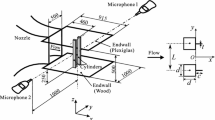Abstract
Pressure distributions on slender body were measured in a low-speed wind tunnel at 40° angle of attack. Twin wires longitudinally applied on both sides of the model at an azimuthal orientation 52.5°. Compared with the result of natural transition, the pressure contributions of twin-wire model exhibit a premature transition and an earlier turbulent separation. Behavior of the flow around slender body in post critical Reynolds region can be obtained in a low Reynolds region. Five different sizes of wire were applied in the test, i.e. 0.1, 0.3, 0.5, 0.7 and 1mm in diameter. Through comparing the pressure distributions of model with different wires, it can be concluded that wire diameter only affect the magnitude of initial post critical Reynolds number, rather than the characteristics of the flow around slender body. The thicker the wire is, the earlier turbulence separation appears, thereby accompanying a decrease in the initial post critical Reynolds number.
Access this chapter
Tax calculation will be finalised at checkout
Purchases are for personal use only
Preview
Unable to display preview. Download preview PDF.
Similar content being viewed by others
References
Lamont P J, Hunt B L. Pressure and force distribution on a sharp-nosed circular cylinder at angles of inclination to a uniform subsonic stream. Journal of Fluid Mechanics, 76(3): 1971; 519–559
Hunt B L. Asymmetric vortex forces and wakes on slender bodies. AIAA 82–1336
Gibbings J C, Goksel O T, Hall D J. The influence of roughness trips upon boundary-layer transition, Part 1 Characteristics of wire trips. Aeronautical Journal, Oct. 1986
Hall R M, Banks D W. Progress in developing gritting techniques for high angle of attack flows. AIAA 94-0169, 1994
Chen Y, Deng X Y, Ma B F, Wang Y K. An investigation of artificial transition technique applied on slender revolution body at high incidence. In: The 5th Asian-Pacific Conference on Aerospace Technology and Science, Nov. 2006
Deng X Y, Chen X R, Wang Y K, et al. Influence of nose perturbations on behaviors of asymmetric vortices over slender body. AIAA 2002-4710, 2002
Author information
Authors and Affiliations
Editor information
Editors and Affiliations
Rights and permissions
Copyright information
© 2007 Tsinghua University Press & Springer
About this paper
Cite this paper
Chen, Y., Deng, X.Y., Wang, Y.K. (2007). Effect of Wire Trips on the Flow over Slender Body at High Angle of Attack. In: Zhuang, F.G., Li, J.C. (eds) New Trends in Fluid Mechanics Research. Springer, Berlin, Heidelberg. https://doi.org/10.1007/978-3-540-75995-9_74
Download citation
DOI: https://doi.org/10.1007/978-3-540-75995-9_74
Publisher Name: Springer, Berlin, Heidelberg
Print ISBN: 978-3-540-75994-2
Online ISBN: 978-3-540-75995-9
eBook Packages: Physics and AstronomyPhysics and Astronomy (R0)




